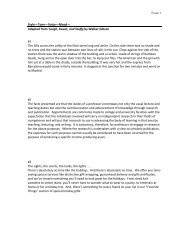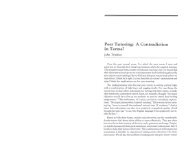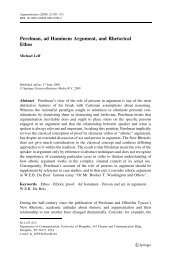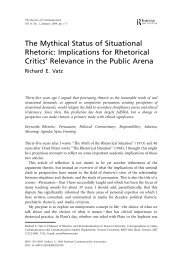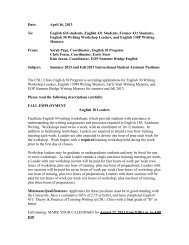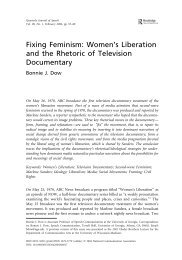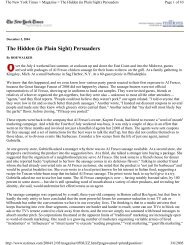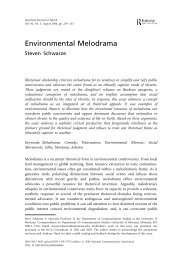The anatomy of a photojournalistic icon ... - CompHacker
The anatomy of a photojournalistic icon ... - CompHacker
The anatomy of a photojournalistic icon ... - CompHacker
You also want an ePaper? Increase the reach of your titles
YUMPU automatically turns print PDFs into web optimized ePapers that Google loves.
Visual Communication<br />
http://vcj.sagepub.com<br />
<strong>The</strong> <strong>anatomy</strong> <strong>of</strong> a <strong>photojournalistic</strong> <strong>icon</strong>: marginalization <strong>of</strong> dissent in the selection and framing <strong>of</strong> ‘a<br />
death in Genoa’<br />
David D. Perlmutter and Gretchen L. Wagner<br />
Visual Communication 2004; 3; 91<br />
DOI: 10.1177/1470357204039600<br />
<strong>The</strong> online version <strong>of</strong> this article can be found at:<br />
http://vcj.sagepub.com/cgi/content/abstract/3/1/91<br />
Published by:<br />
http://www.sagepublications.com<br />
Additional services and information for Visual Communication can be found at:<br />
Email Alerts: http://vcj.sagepub.com/cgi/alerts<br />
Subscriptions: http://vcj.sagepub.com/subscriptions<br />
Reprints: http://www.sagepub.com/journalsReprints.nav<br />
Permissions: http://www.sagepub.com/journalsPermissions.nav<br />
Citations (this article cites 27 articles hosted on the<br />
SAGE Journals Online and HighWire Press platforms):<br />
http://vcj.sagepub.com/cgi/content/refs/3/1/91<br />
Downloaded from http://vcj.sagepub.com at PENNSYLVANIA STATE UNIV on February 6, 2008<br />
© 2004 SAGE Publications. All rights reserved. Not for commercial use or unauthorized distribution.
visual communication<br />
ARTICLE<br />
<strong>The</strong> <strong>anatomy</strong> <strong>of</strong> a <strong>photojournalistic</strong> <strong>icon</strong>:<br />
marginalization <strong>of</strong> dissent in the selection<br />
and framing <strong>of</strong> ‘a death in Genoa’<br />
DAVID D. PERLMUTTER<br />
Louisiana State University<br />
GRETCHEN L. WAGNER<br />
Skidmore College, Saratoga Springs, NY<br />
ABSTRACT<br />
This study examines the case <strong>of</strong> a recent news ‘<strong>icon</strong>’, a celebrated product<br />
<strong>of</strong> photojournalism, Dylan Martinez’s so-called ‘death in Genoa’. <strong>The</strong><br />
picture shows a scene moments before the death by police gunfire <strong>of</strong> a<br />
protester during the Group <strong>of</strong> Eight (G8) summit in Genoa in July 2001. <strong>The</strong><br />
image was chosen by news and political elites as a metonym for the<br />
antiglobalization movement. Fitting into the typical characteristics and<br />
assumptions <strong>of</strong> the news <strong>icon</strong>, it served less to show what happened than<br />
to direct public gaze and interpretations to framed ‘meanings’ that, in this<br />
instance, marginalized a strike against authority by establishing ‘protestor<br />
violence’ as the news lead. <strong>The</strong> study highlights news photography’s<br />
interpretive role <strong>of</strong> historical events and their context and complexity.<br />
KEY WORDS<br />
effects • framing • <strong>icon</strong> • metonym • news • photojournalism • protest •<br />
schema • signage • spectacle<br />
On the afternoon <strong>of</strong> 20 July 2001, during the Group <strong>of</strong> Eight (G8) summit in<br />
Genoa, Italy, Dylan Martinez <strong>of</strong> the Reuters agency photographed the events<br />
before, during and after the death <strong>of</strong> a man named Carlo Giuliani. As one <strong>of</strong><br />
the several thousand individuals who gathered to contest the three-day<br />
economic conference attended by delegates from eight Western nations,<br />
Giuliani, a 23-year-old antiglobalization protester, was shot in the head by a<br />
member <strong>of</strong> the carabinieri, the Italian military police force, on a narrow path<br />
in the ancient city’s downtown area. <strong>The</strong> armed <strong>of</strong>ficer’s vehicle had entered<br />
one <strong>of</strong> the larger streets where both riot police and protesters had gathered<br />
when a group <strong>of</strong> young men, including Giuliani, clad in makeshift riot gear<br />
assembled from moped safety helmets, homemade shields and gas masks,<br />
Copyright © 2004 SAGE Publications (London, Thousand Oaks, CA and New Delhi:<br />
www.sagepublications.com) /10.1177/1470357204039600<br />
Vol 3(1): 91–108 [1470-3572(200402)3:1; 91–108]<br />
Downloaded from http://vcj.sagepub.com at PENNSYLVANIA STATE UNIV on February 6, 2008<br />
© 2004 SAGE Publications. All rights reserved. Not for commercial use or unauthorized distribution.
Figure 1 Giuliani (in black balaclava helmet) pictured behind a police jeep during the anti-G8 protest, 20 July 2001, Genoa. Photo: Dylan Martinez, Reuters.<br />
92<br />
Visual Communication 3(1)<br />
Downloaded from http://vcj.sagepub.com at PENNSYLVANIA STATE UNIV on February 6, 2008<br />
© 2004 SAGE Publications. All rights reserved. Not for commercial use or unauthorized distribution.
approached the <strong>of</strong>ficers’ jeep from behind and the side, throwing objects at it<br />
and breaking its windows. Obstructed by a cement barricade and,<br />
consequently, unable to drive forward to distance their vehicle from the<br />
aggressive protesters, the <strong>of</strong>ficers began to maneuver their vehicle. During<br />
these moments, a gun emerged from the jeep’s smashed rear window, a shot<br />
rang out, a protester – Giuliani – was fatally wounded by the fired bullet, a<br />
journalist took photographs, and a controversy was born: both a legal battle<br />
to determine responsibility for a man’s death and a struggle to define the<br />
symbolic and political meaning <strong>of</strong> the images documenting the event as well<br />
as its antecedents and aftermath.<br />
Of the many pictures taken by Martinez and hundreds taken by other<br />
photographers during the three days in July, only one was eventually<br />
accorded international notoriety: in this photo, Giuliani, wearing a black<br />
balaclava on his head, stands at the rear <strong>of</strong> the jeep with his back to the<br />
viewer and holds what has been reported to be a fire extinguisher. 1 As he lifts<br />
the object in the air, another protester prods the jeep with a wooden plank. In<br />
the shattered rear window <strong>of</strong> the vehicle, a pistol held by an obscured<br />
passenger seems to be aimed at Giuliani. As a backdrop to this action, the<br />
buildings behind show signs <strong>of</strong> the vandalism that had occurred throughout<br />
the city in previous days as a result <strong>of</strong> the anti-G8 protests. Most noteworthy<br />
– serving for many news viewers as the internal lexical framing, or signage,<strong>of</strong><br />
the picture – the words ‘NO MORE COPS’ (in English) are spray-painted on<br />
a wall in the background. In addition, all the storefronts included in the<br />
photograph have been secured with metal grills or panels and the portion <strong>of</strong><br />
the street pictured in the image appears to be littered with broken objects<br />
and trash.<br />
<strong>The</strong> fatal encounter was not a coincidental meeting <strong>of</strong> the agents <strong>of</strong><br />
authority, protest and press. Martinez, along with an army <strong>of</strong> other<br />
international journalists and photojournalists, gathered in Genoa to cover<br />
the much-anticipated assembly <strong>of</strong> heads <strong>of</strong> state from the world’s leading<br />
industrialized nations. Initiated in the 1970s by George Shultz, the US<br />
Treasury Secretary at the time, the G8 summit was initially intended to<br />
provide an informal platform for economic strategists from various Western<br />
nations to come together and discuss international finance. In recent years,<br />
these meetings have grown both in scale and scope, and now include leaders<br />
from Britain, Canada, France, Germany, Italy, Japan, Russia and the United<br />
States, who come together to brainstorm political as well as economic<br />
matters. Since the early 1990s, the G8, plus many other summits with the<br />
same objectives (including the World Economic Forum in Davos,<br />
Switzerland and the World Trade Organization meeting held in Seattle in<br />
1999), have become settings for confrontation – physically between<br />
protesters and local law-enforcement authorities and symbolically between<br />
myriad antiglobalization groups and the leaders <strong>of</strong> the global economy.<br />
<strong>The</strong> protests are obviously attractive to media pr<strong>of</strong>essionals in an age<br />
<strong>of</strong> visually driven news and have been ritually featured on the front page <strong>of</strong><br />
P erlmutter & Wagner: <strong>The</strong> <strong>anatomy</strong> <strong>of</strong> a <strong>photojournalistic</strong> <strong>icon</strong> 93<br />
Downloaded from http://vcj.sagepub.com at PENNSYLVANIA STATE UNIV on February 6, 2008<br />
© 2004 SAGE Publications. All rights reserved. Not for commercial use or unauthorized distribution.
newspapers and news magazines, and been used as lead items on broadcast<br />
news. <strong>The</strong> effects <strong>of</strong> their sensational displays, however, are problematic for<br />
both G8 leaders and protesters. Certainly the national leaders have been<br />
forced to respond, at least rhetorically, to the protesters’ allegations <strong>of</strong> causal<br />
links between the sprawl <strong>of</strong> global capitalism and the resulting<br />
environmental degradation and developing world poverty. For example, at<br />
the Genoa meeting, the UK Prime Minister Tony Blair boasted to reporters at<br />
the summit’s close: ‘For the first time we’ve got a positive, definitive process<br />
and plan for dealing with the problems <strong>of</strong> Africa’ (Blair, 2001). Collectively,<br />
indeed, the participating delegates issued a final statement verbalizing their<br />
commitment to global topics, such as the spread <strong>of</strong> AIDS, debt relief for poor<br />
countries, international trade agreements, and environmental protection<br />
(Summit Summary, 2001). Also, for the first time in G8 history, heads <strong>of</strong> state<br />
from less-affluent nations, such as countries in Africa and Central America,<br />
were included in selected discussions during the three-day meeting (Sanger,<br />
2001: 7; Tagliabue, 2001b; see also Tagliabue, 2001a).<br />
At the same time, the G8 protesters have been criticized by many in<br />
the punditocracy – the op-ed and editorial commentators <strong>of</strong> mainstream<br />
political persuasions. Indeed, liberal commentators regularly cast doubt on<br />
the globalization protesters as a group too loosely organized, too prone to<br />
theatricality and violence, too radical in their aims, and too split in opinion<br />
to be effective. <strong>The</strong> day following the death <strong>of</strong> Giuliani, the New York Times<br />
added to this reputation by quoting several non-violent protesters on the<br />
streets <strong>of</strong> Genoa who had taken it upon themselves to verbally scold and even<br />
chase away their fellow marchers caught damaging property. <strong>The</strong> article<br />
closes by pointing out that ‘issues <strong>of</strong> third world debt and unfettered<br />
capitalism were not foremost on many protesters’ minds’, as self-defense and<br />
avoidance <strong>of</strong> violence had taken center stage (Sanger, 2001: 7). <strong>The</strong> violence<br />
associated with the protests – not to mention the physical appearance and<br />
radical rhetoric <strong>of</strong> the more flamboyant protesters – is <strong>of</strong>ten cited as the root<br />
<strong>of</strong> current mainstream skepticism for a movement seemingly undermining<br />
itself.<br />
<strong>The</strong> shooting in Genoa and the resulting imagery, then, provide an<br />
opportunity to investigate how and why news images are chosen and how<br />
they, alone, come to represent the events with which they are connected.<br />
<strong>The</strong>y function as both a metonym (a picture that is taken to stand for a wider<br />
event) and a ‘site <strong>of</strong> struggle’ for the interpretation <strong>of</strong> the antiglobalization<br />
cause. Moreover, the process by which one <strong>of</strong> the thousands <strong>of</strong> images in the<br />
global news stream is favored over the others is partly an aesthetic one but<br />
also, to a large extent, a politically motivated process <strong>of</strong> manufacture and<br />
spin, not a natural selection (Perlmutter, 1997, 1998, 2003). This study seeks<br />
to illuminate how these elevated journalistic photographs, news <strong>icon</strong>s, or ‘big<br />
pictures’ (Perlmutter, 2003) can be appreciated not just as striking<br />
compositions but also as rhetorical tools wielded by numerous, and <strong>of</strong>ten<br />
diverse, appropriating parties to support their respective arguments.<br />
94<br />
Visual Communication 3(1)<br />
Downloaded from http://vcj.sagepub.com at PENNSYLVANIA STATE UNIV on February 6, 2008<br />
© 2004 SAGE Publications. All rights reserved. Not for commercial use or unauthorized distribution.
<strong>The</strong> case <strong>of</strong> the ‘death in Genoa’ image, thus, highlights that visual<br />
news <strong>icon</strong>s are not natural ‘windows’ onto the world, as the most standard<br />
analogue proposed by news pr<strong>of</strong>essionals describes them. Rather,<br />
photojournalism’s output is as manufactured and framed for consumption<br />
as any other news product. Once created, captioned and imposed on<br />
audiences, however, the actual effect <strong>of</strong> pictures in the press is not<br />
simplistically predictable, and their interpretation is subject to change and<br />
debate.<br />
BACKGROUND: MASS-MEDIATED PROTEST<br />
DEMONSTRATIONS<br />
One crucial context <strong>of</strong> the Genoa shooting <strong>icon</strong> is the phenomenon <strong>of</strong> the<br />
mass-mediated demonstration. Obviously, large and <strong>of</strong>ten violent protests<br />
against existing power structures or social orders have taken place<br />
throughout history, including such famous cases as the plebes and proles <strong>of</strong><br />
Rome, the Blue and Green factions <strong>of</strong> Byzantium, the Jacquerie <strong>of</strong> the Middle<br />
Ages, the rowdy patriots <strong>of</strong> the Boston Tea Party, and the various movements<br />
<strong>of</strong> the 1960s and 1970s, right up to the protests against the Iraq war in 2003.<br />
Such actions – even when they precipitated outright revolt – have always<br />
included a component <strong>of</strong> theatricality. However, in a modern age <strong>of</strong> instant,<br />
global mass communication, groups opposing the existing political, social,<br />
cultural or economic order are faced with the practical, political, psychological<br />
and existential quandary that might be summed up by the<br />
Hamletian paraphrase, ‘To be a media spectacle or not to be a media<br />
spectacle’<br />
On the one hand, outsiders and fringe-dwellers – that is, coalitions or<br />
single groups <strong>of</strong> people holding opinions that deviate from mainstream<br />
popular and <strong>of</strong>ficial thought – need attention for their causes to attract<br />
financial and material support as well as recruits. Most groups, from middleclass<br />
citizens protesting cuts in their local school’s budget to a terrorist group<br />
seeking global power, recognize the need to attract the spotlight <strong>of</strong> mass<br />
media. Airtime and newsprint space, thus, are the sine qua non <strong>of</strong> anyone<br />
seeking societal change <strong>of</strong> any kind.<br />
On the other hand, those very publicity-seeking tactics may<br />
ultimately distort, radicalize, trivialize and even undermine a group’s cause,<br />
especially in the view <strong>of</strong> their more moderate proponents or non-agendasharing<br />
allies. Worse, the acquisition <strong>of</strong> space in the newshole, the<br />
governmental, press and public agenda, may constitute for the protest groups<br />
a lost victory <strong>of</strong> public relations. <strong>The</strong>y become famous for 15 minutes simply<br />
for what they do (or look like), not the principles, policies or programs they<br />
advocate or oppose.<br />
In response to this challenge, protesters <strong>of</strong>ten evolve their own voice,<br />
that is, their private sets <strong>of</strong> symbols, sounds, bodily stances and articulations<br />
that express their own sets <strong>of</strong> beliefs, however ‘discordant’ to the eyes and<br />
P erlmutter & Wagner: <strong>The</strong> <strong>anatomy</strong> <strong>of</strong> a <strong>photojournalistic</strong> <strong>icon</strong> 95<br />
Downloaded from http://vcj.sagepub.com at PENNSYLVANIA STATE UNIV on February 6, 2008<br />
© 2004 SAGE Publications. All rights reserved. Not for commercial use or unauthorized distribution.
ears <strong>of</strong> mainstream press elites and the general public (DeLuca, 1999: 9–21;<br />
Sanger, 1997: 179–95; Simonson, 2001: 399–420; Stewart, 1999: 91–105).<br />
Indeed, in many cases, widely publicized protest movements might not be<br />
interested in public communication but may be more focused on reaching a<br />
specific (self-referenced) community or may be disdainful <strong>of</strong> wider public<br />
acceptance (Lake, 1983: 127–42; Low, 1996: 101–9; Terrill, 2001: 25–53).<br />
In contrast, movements seeking mainstream connections and<br />
acceptance try to create narrative structures and visual symbols that may<br />
connect to (in research terms, they try to activate the schemas <strong>of</strong>) mainstream<br />
audiences. Martin Luther King’s religious framing <strong>of</strong> the black<br />
struggle for civil rights and equality was an example <strong>of</strong> one such tactic in that<br />
he appealed to Judeo-Christian and American traditions for moral suasion<br />
(Selby, 2001: 68–93). In other cases, spectacle-oriented protests may have<br />
multiple and diverse internal and external target audiences (Watkins, 2001:<br />
83–101). Finally, different groups with similar goals may choose tactics that<br />
are moderate or militant, compromising or confrontational, working within<br />
a system or in opposition to it (Kowal, 2000: 240–55).<br />
Examples <strong>of</strong> the complexities <strong>of</strong> the protester image abound, but all<br />
reinforce a certifiable observation: most people’s view <strong>of</strong> protest movements<br />
is filtered by mass media (Stamou, 2001: 653–80). News coverage <strong>of</strong> political<br />
issues and protest movements thus affects public perceptions and may even<br />
be said to spur ‘opinion’ about the protesters and their perceptually defined<br />
causes (McLeod, 1995: 4–19; McLeod and Detenber, 1999: 3–23; Shoemaker,<br />
1984: 66–75; Wittebols, 1996: 345–61). For example, during the 1960s and<br />
early 1970s a large majority <strong>of</strong> the public, when surveyed, reacted negatively<br />
to anti-Vietnam War protesters (Gustainis and Hahn, 1988: 203–16; Kernell,<br />
1978: 506–22; Milstein, 1974; Mueller, 1971, 1973; Robinson, 1970: 1–9). It is<br />
unclear, however, whether such feelings were engendered by antipathy to the<br />
goals <strong>of</strong> the more moderate wing <strong>of</strong> the movements or by the theatrical (and<br />
media-attracting protest) tactics <strong>of</strong> some anti-war protesters (Fiske, 1987:<br />
284; see also Domke et al., 2003: 193–221). As Todd Gitlin described in his<br />
classic study, <strong>The</strong> Whole World is Watching (1981), media attention is a twoedged<br />
sword in that it can make and unmake a protest movement because<br />
mass media tend to focus on the most sensational rhetoric or actions <strong>of</strong> the<br />
more radical elements. Other crucial definitions are those <strong>of</strong> ‘legitimacy’ and<br />
‘worthiness’ – that some protesters are worthy victims and to be accorded<br />
sympathy, e.g. the anti-government Tiananmen Square students, and others<br />
are unworthy (and almost execrable), e.g. anti-government Korean student<br />
demonstrators (Kim, 2000: 22–36; Larson and Chen, 1992: 78–104;<br />
Perlmutter, 1998). Finally, news media can choose to strip protesters <strong>of</strong> any<br />
political voice by focusing on their events and displays only as entertainment,<br />
not as meaningful expressions <strong>of</strong> opinion (Dow, 1999: 143–57; Ewen, 1988:<br />
265).<br />
Contemporary antiglobalization protests and movements are caught<br />
in these same struggles for attention, definition, legitimacy and worthiness.<br />
96<br />
Visual Communication 3(1)<br />
Downloaded from http://vcj.sagepub.com at PENNSYLVANIA STATE UNIV on February 6, 2008<br />
© 2004 SAGE Publications. All rights reserved. Not for commercial use or unauthorized distribution.
Since the late 1990s, civil rights groups, environmental organizations and<br />
students from around the world campaigning for a variety <strong>of</strong> humanitarian<br />
causes have criticized global economic summits. To show their disapproval <strong>of</strong><br />
the exclusive, hierarchical and (perceived) anti-poor, anti-environmental<br />
agenda <strong>of</strong> these meetings and the general failure to disclose decision-making<br />
processes to the public, demonstrators have gathered in ever-increasing<br />
numbers at the sites <strong>of</strong> meetings, such as that <strong>of</strong> the G8 and <strong>of</strong> the World<br />
Trade Organization. Advocating a diversity <strong>of</strong> causes and aligning themselves<br />
under the umbrella term ‘antiglobalization’, these activists claim to resist<br />
expanding, non-democratic corporate power. However, different subgroups<br />
choose to fight against manifestations <strong>of</strong> what they perceive to be Western<br />
economic privilege (see Klein, 1999). <strong>The</strong> antiglobalization protest movement<br />
at the 1999 World Trade Organization meeting in Seattle, Washington,<br />
and the ensuing violence surrounding it, triggered a rush <strong>of</strong> international<br />
consciousness and protest events at subsequent economic summits. <strong>The</strong>se<br />
included acts <strong>of</strong> civil disobedience in Prague in September 2000, in Quebec<br />
City in April 2001, and in Göteborg, Sweden shortly before the ‘death in<br />
Genoa’ (Fleischhauer et al., 2001: 24–5).<br />
To complicate matters further, the antiglobalization movement is split<br />
internally among factions that disagree about the proper tactics for protest as<br />
well as the ultimate aims <strong>of</strong> the struggle. <strong>The</strong> most pronounced differences<br />
exist between the groups who advocate non-violent disobedience, those<br />
individuals who wish to answer (what they perceive to be) police violence<br />
with more <strong>of</strong> the same, and even those who consider property destruction as<br />
a necessary form <strong>of</strong> protest. In internal nomenclature there are the ‘greens’<br />
versus the ‘blacks’. Anarchist (or ‘black’) groups have received most <strong>of</strong> the<br />
blame for the defacement <strong>of</strong> property and attempts to injure police at the<br />
various summits. Ya Basta! (Enough Already!) is one <strong>of</strong> the more prominent<br />
anarchist, or ‘direct action’ groups, which came into being during the mid-<br />
1990s, inspired by Mexico’s Zapatista rebels. Sympathizers with this group<br />
are easily recognized by their white overalls, which are meant to symbolize<br />
the invisibility <strong>of</strong> the marginalized populations. At the G8 in Genoa, Tutte<br />
Bianche (White Overalls), a group that emerged in 1998 out <strong>of</strong> the Ya Basta!<br />
movement, was joined by fellow anarchists, the Black Bloc, as the prominent<br />
perpetrators <strong>of</strong> violence. Instead <strong>of</strong> sporting white, the Black Bloc were<br />
known for their black attire and head coverings. Notably, this was the type <strong>of</strong><br />
clothing <strong>of</strong>ten pictured in photographs <strong>of</strong> the destruction in Genoa and<br />
particularly the stocking cap worn by Carlo Giuliani (cf. Ratnesar, 2001: 34).<br />
Unsurprisingly, at the same time, massive security became a feature <strong>of</strong><br />
all global economic meetings. Genoa was no exception. As a precaution to<br />
deter what its federal police called ‘potential suspects’ from entering the<br />
country, Italy suspended the Schengen Treaty covering intra-European travel.<br />
<strong>The</strong> authorities’ abrogation <strong>of</strong> this policy, which guarantees unrestricted<br />
travel throughout the European Union, caused hundreds <strong>of</strong> travelers to be<br />
turned away at the Italian border. <strong>The</strong> targeted individuals included those<br />
P erlmutter & Wagner: <strong>The</strong> <strong>anatomy</strong> <strong>of</strong> a <strong>photojournalistic</strong> <strong>icon</strong> 97<br />
Downloaded from http://vcj.sagepub.com at PENNSYLVANIA STATE UNIV on February 6, 2008<br />
© 2004 SAGE Publications. All rights reserved. Not for commercial use or unauthorized distribution.
already on police watch lists and those carrying banners, accessories and<br />
black clothing thought to be indicators <strong>of</strong> their participation in the Black<br />
Bloc (see Dickey and Nordland, 2001: 23). All railways, highways, airports<br />
and seaports servicing Genoa were closed for the duration <strong>of</strong> the summit,<br />
making entry even more difficult. Those lucky enough to arrive in Genoa<br />
were faced with further traffic restrictions, particularly the barricaded ‘red<br />
zone’ that was erected around the section <strong>of</strong> the city hosting the talks. This<br />
constructed fortress angered many <strong>of</strong> the protesters already agitated by the<br />
exclusive nature <strong>of</strong> the summit meetings. As a result, it became the goal <strong>of</strong><br />
many <strong>of</strong> the demonstrators to surmount this physical (and, to their<br />
perception, ideological) barrier and defeat police measures to stop them. In<br />
sum, the stage <strong>of</strong> Genoa was set for violence and mass media attention. <strong>The</strong><br />
more incendiary-minded protesters saw authorities stifling dissent and<br />
declaring a form <strong>of</strong> war on them; the police were primed to expect the worst<br />
sort <strong>of</strong> hooliganism; and the world press corps eagerly prepared to cover<br />
what promised to be colorful and spectacular protests and confrontations.<br />
THE MAKING OF AN ICON<br />
Many images <strong>of</strong> police and protesters combating each other in the streets <strong>of</strong><br />
Genoa were produced during the July weekend. However, the Dylan<br />
Martinez picture was a prominent <strong>icon</strong> in journalistic portrayals about the<br />
summit events (see Table 1).<br />
Moreover, the photograph has come to demonstrate characteristics<br />
common to pictures that have achieved an elevated level <strong>of</strong> fame and<br />
recognition in our media-saturated world – that is, the standard elements <strong>of</strong><br />
a <strong>photojournalistic</strong> <strong>icon</strong>. Following Perlmutter’s (1998) typology, these<br />
include: (1) importance <strong>of</strong> the event depicted, (2) metonymy, (3) celebrity,<br />
(4) prominence <strong>of</strong> display, (5) frequency <strong>of</strong> use, and (6) primordiality. What<br />
is most revealing overall is that Martinez’s photograph is a generic <strong>icon</strong>,<br />
providing a scenario <strong>of</strong> conflict that came to represent incidents <strong>of</strong> violence<br />
in general within the antiglobalization movement and not just one moment<br />
in Genoa (Perlmutter, 1998: 11). By examining each item in this list, we can<br />
excavate the characteristics that allow this image to be used as an encapsulation<br />
and exemplification <strong>of</strong> the complex issues <strong>of</strong> the antiglobalization<br />
conflict.<br />
<strong>The</strong> first characteristic, the importance <strong>of</strong> the pictured event, is a key<br />
component contributing to the <strong>icon</strong>ic status <strong>of</strong> this photograph. Martinez’s<br />
series <strong>of</strong> photographs document the first death to take place at an<br />
international economic summit. Since the 1999 World Trade Organization<br />
meeting in Seattle, the number <strong>of</strong> demonstrations staged in cities hosting<br />
these conferences has been growing along with the frequency <strong>of</strong> violence.<br />
Earlier in the summer <strong>of</strong> 2001, three protesters had been shot, although not<br />
fatally, in Göteborg, Sweden, where leaders <strong>of</strong> the European Union were<br />
gathering. This incident shocked many involved in the antiglobalization<br />
98<br />
Visual Communication 3(1)<br />
Downloaded from http://vcj.sagepub.com at PENNSYLVANIA STATE UNIV on February 6, 2008<br />
© 2004 SAGE Publications. All rights reserved. Not for commercial use or unauthorized distribution.
Table 1 Press reports <strong>of</strong> the ‘death in Genoa’<br />
Periodical, date Headline Byline Caption<br />
Time Death in Genoa Michael Elliott Lethal Force: Giuliani joins an<br />
30 July 2001 attack on police, a pistol is aimed<br />
at him from the van, medics<br />
attend to him after he is shot and<br />
run over.<br />
Newsweek First Blood: Death and Christopher Dickey <strong>The</strong> 23-year-old Giuliani prepares<br />
30 July 2001 violence in Genoa may and Rod Nordland to heave a fire extinguisher at the<br />
mark a permanent split<br />
rear window, where a carabiniere<br />
in the antiglobalization<br />
is aiming a pistol.<br />
ranks. Radical hooligans,<br />
one moderate says sadly,<br />
‘have hijacked the whole<br />
thing.’<br />
New York Times Italian protester is killed David E. Sanger and Just before he was shot, a<br />
21 July 2001 by police at Genoa Alessandra Stanley protester, Carlo Giuliani, tried to<br />
meeting<br />
hurl a fire extinguisher at a police<br />
vehicle in Genoa as an <strong>of</strong>ficer<br />
aimed a pistol.<br />
Chicago Tribune Riots turn Genoa into a Tom Hundley and A paramilitary police <strong>of</strong>ficer<br />
23 July 2001 war zone, 1 killed, Bob Kemper points his gun at a protestor who<br />
hundreds injured<br />
is about to hurl an object into the<br />
rear <strong>of</strong> his besieged vehicle during<br />
Friday’s riots in connection to the<br />
G8 summit.<br />
Los Angeles Times Summit opens amid James Gerstenzang A policeman points a gun at a<br />
21 July 2001 deadly street protests protestor lifting a fire extinguisher<br />
in the air. <strong>The</strong> demonstrator is<br />
killed shortly afterward.<br />
Der Spiegel ‘Murderer, Murderer’. Hans-Juergen Attack on the police jeep,<br />
30 July 2001 <strong>The</strong> dead demonstrator Schlamp and Sven guerrilla-like invasion <strong>of</strong> Genoa’s<br />
in Genoa shocks the Röbel old city; Carabiniere with a pistol,<br />
world<br />
‘Extreme violence on both sides’<br />
movement who were accustomed to martial use <strong>of</strong> tear gas and rubber<br />
bullets for crowd control, but never live ammunition (Ratnesar, 2001: 33).<br />
<strong>The</strong> left-leaning web magazine, <strong>The</strong> Monitor, likened the Genoa events to the<br />
infamous student killings at Kent State University during a Vietnam War<br />
protest (themselves subject <strong>of</strong> a ‘death <strong>of</strong> ...’ <strong>photojournalistic</strong> <strong>icon</strong>):<br />
P erlmutter & Wagner: <strong>The</strong> <strong>anatomy</strong> <strong>of</strong> a <strong>photojournalistic</strong> <strong>icon</strong> 99<br />
Downloaded from http://vcj.sagepub.com at PENNSYLVANIA STATE UNIV on February 6, 2008<br />
© 2004 SAGE Publications. All rights reserved. Not for commercial use or unauthorized distribution.
Genoa is reminiscent <strong>of</strong> nothing so much as Kent State, where, after<br />
hundreds <strong>of</strong> thousands <strong>of</strong> deaths in Southeast Asia, it took the death<br />
<strong>of</strong> four young, privileged American students on a Midwest campus in<br />
May 1970 to galvanize opposition and transform the US anti-war<br />
movement into a force that shut down campuses across the country<br />
for a full season. (Parrish, 2001: 5)<br />
Yet, notably, this statement reveals more hope than prophecy:<br />
manifestly the death <strong>of</strong> a protester in Genoa in 2001 did not incite any sort <strong>of</strong><br />
mass reaction. <strong>The</strong>re was no great ‘galvanization’ nor ‘transformation’ <strong>of</strong> the<br />
antiglobalization movements.<br />
In considering the metonymy <strong>of</strong> the image – how it was used to stand<br />
for or represent the greater event (the Genoa summit) or the general issue<br />
(globalization and its discontents) – the choice, description and use <strong>of</strong> the<br />
photo-<strong>icon</strong> most associated with the modern event explains why the<br />
perceived effects <strong>of</strong> the event may have been so muted or diffuse. For, unlike<br />
the famous ‘woman screaming over body <strong>of</strong> dead student’ image associated<br />
with Kent State, the Genoa picture that received a majority <strong>of</strong> the press space<br />
does not actually depict the moment in which Giuliani was shot or the<br />
moments after the bullet’s impact when Giuliani had been knocked to the<br />
pavement, pinned under a jeep tire, or lying in a pool <strong>of</strong> his own blood.<br />
<strong>The</strong>se later images existed: Martinez and other photographers took them. But,<br />
crucially, the mainstream Western newspapers and magazines chose not to<br />
print them. Indeed, they are available primarily on pro-protester websites that,<br />
<strong>of</strong> course, most ordinary news consumers would not visit. Instead, the <strong>icon</strong><br />
displays the frame photographed directly before the incident and, as a result,<br />
the image functions metonymically, representing the entire story <strong>of</strong> the man’s<br />
death without actually showing it. We, thus, were not shown the victim and<br />
the aftermath <strong>of</strong> the shooting, but the alleged provocation <strong>of</strong> the shooter. <strong>The</strong><br />
visual metonym <strong>of</strong> Genoa was then protester violence, not police violence.<br />
<strong>The</strong> third <strong>icon</strong>ic characteristic <strong>of</strong> the image is its celebrity, promoted<br />
by editors <strong>of</strong> press content who blatantly declare this picture to be particularly<br />
noteworthy. Such statements lead the viewer to believe that one should<br />
pay close attention to the image because <strong>of</strong> its claimed worth and, as a result,<br />
should burn the image into one’s mental data bank (Perlmutter, 1998: 11–12).<br />
One such claim to the picture’s celebrity status appeared in Time on 30 July<br />
2001, when journalist Michael Elliot opened his article, ‘Death in Genoa’, with:<br />
It has already become one <strong>of</strong> those <strong>icon</strong>ic images, like the picture <strong>of</strong> a<br />
naked, napalmed girl running down a Vietnamese road, or a bloodied<br />
American being dragged through the streets <strong>of</strong> Mogadishu. Last<br />
Friday afternoon in the Piazza Alimonda in Genoa, Italy, a<br />
photographer caught a young man getting ready to hurl a fire<br />
extinguisher at a police Land Rover trapped against a wall. (Elliot,<br />
2001: 22)<br />
100<br />
Visual Communication 3(1)<br />
Downloaded from http://vcj.sagepub.com at PENNSYLVANIA STATE UNIV on February 6, 2008<br />
© 2004 SAGE Publications. All rights reserved. Not for commercial use or unauthorized distribution.
Elliot asserts that Martinez’s image is one that has entered the pantheon <strong>of</strong><br />
famous journalistic photographs depicting violence and conflict. With this<br />
maneuver, the commentator equates the current image with familiar <strong>icon</strong>s,<br />
thereby assigning value to the G8 picture new on the scene. Furthermore,<br />
when news or political elites state that a picture will be famous, it is <strong>of</strong>ten a<br />
self-fulfilling prophecy since they are the arbiters <strong>of</strong> which pictures become<br />
famous (Perlmutter, 1997). Only the decades to come will show whether the<br />
prophecy comes true, but at the moment <strong>of</strong> its iteration it further served not<br />
only to accord celebrity status – literally and visually 15 minutes <strong>of</strong> fame in<br />
one frame – for the image, but to point a rhetorical lens at it for an audience<br />
and ascertain that it is the most important picture for us to consider. (And, <strong>of</strong><br />
course, this article participates in the process <strong>of</strong> celebrity-making. Academics<br />
are part <strong>of</strong> the machine <strong>of</strong> imposing status on any text, from an oil painting<br />
to a news photo.)<br />
In addition to heralding the significance <strong>of</strong> this image, reporters and<br />
editors granted the picture a prominent position and frequent appearances<br />
in their publications. Both the Los Angeles Times and the Chicago Tribune<br />
placed Martinez’s photograph on the front page <strong>of</strong> the Saturday, 21 July<br />
edition, the day after Giuliani was shot. Also on Saturday, the New York Times<br />
used the image in their Section A article reporting the disquiet in Genoa. 2<br />
Within the following week, both Newsweek and Time presented a series <strong>of</strong><br />
images from the Martinez sequence to illustrate their coverage <strong>of</strong> the<br />
violence, placing the image <strong>of</strong> Giuliani with the fire extinguisher as the<br />
central and prominent photograph in their spreads. In addition to such<br />
popular news media, smaller, mostly web-based, independent news sources<br />
uploaded Martinez’s photographs on their web sites. Indymedia (2001)<br />
served as one <strong>of</strong> the most comprehensive suppliers <strong>of</strong> information regarding<br />
the G8 summit among the alternative press centers. As demonstrated by<br />
these examples, many different types <strong>of</strong> media sources repeatedly used<br />
Giuliani’s confrontation with the police jeep to visually represent the events<br />
that occurred in Genoa.<br />
Finally, this image, like many <strong>photojournalistic</strong> <strong>icon</strong>s, can be read as a<br />
representation <strong>of</strong> a primordial theme – a theme embedded in a specific visual<br />
and literary culture – <strong>of</strong> conflict, that <strong>of</strong> the ‘underdog’ who decides to take<br />
on the powers that be. This is not to say that any image contains a natural<br />
idea or theme; rather we recognize an idea by previous mnemonic<br />
association, or by being reminded <strong>of</strong> such connection by captions or<br />
suggestive allusions. So a pro-protester might suggest a theme in line with the<br />
story <strong>of</strong> David versus Goliath, where the less-equipped individual challenges<br />
a stronger and more authoritative opponent. However, with the image <strong>of</strong><br />
Giuliani lifting a fire extinguisher, it is difficult to detect which opponent, the<br />
police or the protester, is the actual underdog. <strong>The</strong> protesters are less<br />
martially equipped; however, they still do a fine job <strong>of</strong> destroying police<br />
property. Read either way, it is a story <strong>of</strong> victims – either the protesters<br />
oppressed by the ‘system’ or the police being unjustly assaulted. Such<br />
P erlmutter & Wagner: <strong>The</strong> <strong>anatomy</strong> <strong>of</strong> a <strong>photojournalistic</strong> <strong>icon</strong> 101<br />
Downloaded from http://vcj.sagepub.com at PENNSYLVANIA STATE UNIV on February 6, 2008<br />
© 2004 SAGE Publications. All rights reserved. Not for commercial use or unauthorized distribution.
ambiguity is resolved for the viewer when the respective mainstream media<br />
sources frame the image for reader consumption through captions.<br />
FRAMING THE IMAGE<br />
As the visual anthropologist Sol Worth noted, most audiences receive an<br />
edemic (edited, published) rather than cademic (as photographed, unedited,<br />
unprinted) version <strong>of</strong> photographic narratives (Worth, 1981). What we are<br />
allowed to see has socio-political importance because mental schemas can be<br />
established and activated by the frames through which media represent<br />
issues, events and persons in the news and even by the mere choice <strong>of</strong><br />
determining a topic newsworthy (Berkowitz and Rogers, 1986; Domke et al.,<br />
1998; Fiske and Linville, 1980; Graber, 1988). For most stories, most news<br />
viewers and readers cannot be on site while the events occurred. We rely on<br />
others, typically mainstream news gatherers and disseminators, to report to<br />
us what they allege they saw, show us what they claim to have ‘captured’ on<br />
video, film or digital media and, <strong>of</strong>ten, tell us what we should think about<br />
what we are being told and shown. In many cases, the audience has little<br />
access to (and little tendency to seek out) alternative views and narrations <strong>of</strong><br />
news events. <strong>The</strong>refore it is important, first, to identify the frame that<br />
mainstream media choose in terms <strong>of</strong> any image selected for popularization<br />
in the place <strong>of</strong> other possible or available images. <strong>The</strong>n we can further<br />
appreciate the associated narratives, descriptions and commentary; that is,<br />
how we were told to see a picture by those who present it to us. One still<br />
photographic image or a video shot and its accompanying captioning, voices<br />
or narration, thus, constitute a single frame <strong>of</strong> interpretation.<br />
In this case, the image <strong>of</strong> Giuliani approaching the back <strong>of</strong> a police<br />
jeep is, as noted, the dominantly selected <strong>icon</strong> by mainstream media.<br />
Notably, it is the fourth in a series <strong>of</strong> 11 images taken in sequence by Dylan<br />
Martinez before, during and after Giuliani’s shooting. Rather than feature the<br />
scene where Giuliani lies contorted on the ground in a pool <strong>of</strong> his blood or<br />
even an image where the police jeep has backed over his body, the<br />
mainstream popular press selected the suggestive image <strong>of</strong> Giuliani lifting the<br />
fire extinguisher and the police <strong>of</strong>ficer pointing the gun out <strong>of</strong> the back <strong>of</strong><br />
the vehicle. Again, the content <strong>of</strong> this image, while subsuming some<br />
ambiguity and complexity <strong>of</strong> plot, still was selected by mainstream media to<br />
assert a simple narrative <strong>of</strong> protester violence, not police violence.<br />
Yet, even a picture whose meaning or ‘plot’ is self-evident to one<br />
person or faction may hold other possible ascriptions <strong>of</strong> meaning for another<br />
person or group.<br />
<strong>The</strong> quotes used to explicate the image in different news sources <strong>of</strong><br />
varying political leanings demonstrate the different interpretations <strong>of</strong> the<br />
photograph. <strong>The</strong> descriptions vilifying Giuliani in major media sources are<br />
as follows (emphases added):<br />
102<br />
Visual Communication 3(1)<br />
Downloaded from http://vcj.sagepub.com at PENNSYLVANIA STATE UNIV on February 6, 2008<br />
© 2004 SAGE Publications. All rights reserved. Not for commercial use or unauthorized distribution.
<strong>The</strong> 23-year-old Giuliani prepares to heave a fire extinguisher at the<br />
rear window, where a carabiniere is aiming a pistol. (Newsweek)<br />
(Dickey and Nordland, 2001: 23)<br />
Just before he was shot, a protester, Carlo Giuliani, tried to hurl a fire<br />
extinguisher at a police vehicle in Genoa as an <strong>of</strong>ficer aimed his pistol.<br />
(New York Times) (Sanger and Stanley, 2001: 7)<br />
A policeman points a gun at a protestor lifting a fire extinguisher in the<br />
air. <strong>The</strong> demonstrator was killed shortly afterward. (Los Angeles<br />
Times) (Gerstenzang, 2001: 1)<br />
In contrast, the independent, left-leaning Monitor suggests:<br />
<strong>The</strong> protesters with the lumber appear to be ready to flee – they have<br />
taken the lumber out <strong>of</strong> the window and have turned away. Carlo<br />
Giuliani now has the fire extinguisher in his hands right in front <strong>of</strong><br />
his face. He is not poised to hurl it. Looking up, he may just have<br />
noticed the carabiniere with the gun. (<strong>The</strong> Monitor) (Parrish, 2001)<br />
Each <strong>of</strong> these four captions highlights the same visual information; the<br />
picture itself remains the same. Each statement, however, <strong>of</strong>fers a different<br />
reading <strong>of</strong> the event, thereby creating a ‘site <strong>of</strong> struggle’ in this image: but<br />
only if the voices <strong>of</strong> struggle are allowed to be heard and their emblematic<br />
images are allowed to be seen.<br />
More revealingly, as a cue to a process <strong>of</strong> purposive framing at work,<br />
many mainstream media sources discontinued their coverage <strong>of</strong> the G8 by the<br />
Monday following Giuliani’s death. It was almost as if once the metonym <strong>of</strong><br />
‘anarchist violence provokes police response’ had been shown and written<br />
up, the work <strong>of</strong> these press agencies was complete. However, an event that<br />
was framed by protesters and sympathizers as even more <strong>of</strong> an outrage<br />
occurred the night after the shooting. <strong>The</strong> police, searching for contraband<br />
and members <strong>of</strong> the Black Bloc, raided the Diaz School, which served as the<br />
headquarters for the Genoa Social Forum – a primary organizer <strong>of</strong> the<br />
weekend’s protests. Despite their denial <strong>of</strong> involvement in violent protest,<br />
members <strong>of</strong> the Genoa Social Forum were physically and verbally assaulted<br />
that evening by the police, their computers and files were confiscated, and<br />
many individuals were arrested. <strong>The</strong>se events earned little if any airtime and<br />
surface area in the media and, most important, photographs <strong>of</strong> the incident<br />
remained largely unprinted, except for amateur snapshots posted on<br />
independent websites. In addition, photographs allegedly documenting the<br />
tactical collaboration between the police and the Black Bloc and their<br />
supposed cooperative instigation <strong>of</strong> violence were also ignored (see Yuen,<br />
2001; see also Tomchick, 2001). <strong>The</strong>refore, an alternative ‘frame’ presenting<br />
the argument that the police had acted harshly and unjustly and that the<br />
protesters were justified in their counterattack never materialized in the more<br />
prominent news venues.<br />
P erlmutter & Wagner: <strong>The</strong> <strong>anatomy</strong> <strong>of</strong> a <strong>photojournalistic</strong> <strong>icon</strong> 103<br />
Downloaded from http://vcj.sagepub.com at PENNSYLVANIA STATE UNIV on February 6, 2008<br />
© 2004 SAGE Publications. All rights reserved. Not for commercial use or unauthorized distribution.
CONCLUSIONS<br />
Over all, the case <strong>of</strong> ‘a death in Genoa’ suggests that the study <strong>of</strong> modern<br />
news imagery must not only be part reception analysis and part general<br />
content analysis but also part <strong>icon</strong> analysis. It is vital to look at the ‘big<br />
pictures’ that gain overriding fame and that garner greater argumentation<br />
than all or any others. While discourse elites who choose the images to print<br />
– including, we are aware, the authors <strong>of</strong> this article – and the public who<br />
turn to them for information are typically exposed to a range <strong>of</strong> imagery on<br />
most public affairs issues, certain images may be retained as exemplars <strong>of</strong> a<br />
picture <strong>of</strong> what happened where, when, to whom and why.<br />
<strong>The</strong>se mnemonic and metonymic functions are crucial to the<br />
shorthand <strong>of</strong> journalism; a picture must stand for a thousand words, but also<br />
must replace a thousand other pictures. Which events are witnessed by<br />
photojournalists, which pictures they decide to take <strong>of</strong> which sections <strong>of</strong> a<br />
greater reality, which ones they send to news organizations, which <strong>of</strong> those<br />
are printed with what captioning and contextual framing and, finally, which<br />
become <strong>icon</strong>s are political as well as aesthetic and industrial choices. Rather<br />
than summing up any reality <strong>of</strong> event, persons, place and time, they <strong>of</strong>fer<br />
cut-out frames <strong>of</strong> a fraction <strong>of</strong> a second and a narrow view. Whatever the<br />
technology that produces both still and moving images, these images are only<br />
time-, setting- and frame-specific ‘anecdotes’ that can never be all <strong>of</strong> reality<br />
(Perlmutter, 1992; Worth, 1981: 162). As such they become examples <strong>of</strong><br />
genres and types <strong>of</strong> news events, serving as tools for purposive ‘exemplification’<br />
by news elites and facilitating the public’s mental storage <strong>of</strong> the event<br />
(see Zillman and Brosius, 2001). This provides all the more reason for<br />
researchers and critics <strong>of</strong> today’s image-driven journalism to excavate the<br />
<strong>icon</strong>s that falsely and superficially seem so sensational in appearance,<br />
definitive in meaning, and transparent in effect.<br />
NOTES<br />
1. <strong>The</strong> origin <strong>of</strong> this ‘fire extinguisher’ designation is uncertain.<br />
Internet discussions have deemed the object to be everything from a<br />
paper box to a Genoa salami to a tear gas canister such as those<br />
carried by riot police. In a frame previous to this photograph, the<br />
object is seen in the back window <strong>of</strong> the jeep. It is unclear whether it<br />
was originally inside the jeep and fell out in the disorder or if it had,<br />
moments before, been thrown into the jeep by the protesters.<br />
2. Although the image does not appear on the front page <strong>of</strong> this paper,<br />
it is printed on page 7 <strong>of</strong> the front section.<br />
REFERENCES<br />
Berkowitz, L. and Rogers, K. (1986) ‘A Priming Effect Analysis <strong>of</strong> Media<br />
Influences’, in J. Bryant and D. Zillman (eds) Perspectives on Media<br />
Effects, pp. 57–81. Hillsdale, NJ: Erlbaum.<br />
104<br />
Visual Communication 3(1)<br />
Downloaded from http://vcj.sagepub.com at PENNSYLVANIA STATE UNIV on February 6, 2008<br />
© 2004 SAGE Publications. All rights reserved. Not for commercial use or unauthorized distribution.
Blair, T. (2001) ‘Statement <strong>of</strong> Prime Minister’, 22 July, URL (consulted 24<br />
Sept. 2001): www.cnn.com/2001/WORLD/europe/07/22/genoa.oakley/<br />
index.html<br />
DeLuca, K. (1999) ‘Unruly Arguments: <strong>The</strong> Body Rhetoric <strong>of</strong> Earth First!, Act<br />
Up, and Queer Nation’, Argumentation and Advocacy 36(1): 9–21.<br />
Dickey, C. and Nordland, R. ( 2001) ‘First Blood’, Newsweek, 30 July: 23.<br />
Domke, D., Perlmutter, D. and Spratt, M. (2003) ‘<strong>The</strong> Primes <strong>of</strong> Our Times An<br />
Examination <strong>of</strong> the “Power” <strong>of</strong> Visual Images’, Journalism 3(2): 131–59.<br />
Domke, D., Shah, D.V. and Wackman, D. (1998) ‘Media Priming Effects:<br />
Accessibility, Association, and Activation’, International Journal <strong>of</strong><br />
Public Opinion Research 1: 51–74.<br />
Dow, B. (1999) ‘Spectacle, Spectatorship, and Gender Anxiety in Television<br />
Coverage <strong>of</strong> the 1970 Women’s Strike for Equality’, Communication<br />
Studies 50(2): 143–57.<br />
Elliott, M. (2001) ‘Death in Genoa’, Time, 30 July: 22–3.<br />
Ewen, S. (1988) All Consuming Images: <strong>The</strong> Politics <strong>of</strong> Style in Contemporary<br />
Culture. New York: Basic Books.<br />
Fiske, J. (1987) Television Culture. New York: Routledge.<br />
Fiske, S. and Linville, P. (1980) ‘What Does the Concept Schema Buy Us’,<br />
Personality and Social Psychology Bulletin 6: 543–57.<br />
Fleischhauer, J., Hogrefe, J., Röbel, S., Schäfer, U., Schiessl, M., Schlamp, H.J.<br />
and Steingart, G. (2001) ‘Widerspruch!’, Der Spiegel, 23 July: 20–32.<br />
Gerstenzang, J. (2001) ‘Summit Opens Amid Deadly Street Protests’, Los<br />
Angeles Times, 21 July: A1.<br />
Gitlin, T. (1981) <strong>The</strong> Whole World Is Watching: Mass Media in the Making and<br />
Unmaking <strong>of</strong> the New Left. Berkeley: University <strong>of</strong> California Press.<br />
Graber, D. (1988) Processing the News: How People Tame the Information Tide.<br />
New York: Longman.<br />
Gustainis, J. and Hahn, D.F. (1988) ‘While the Whole World Watched:<br />
Rhetorical Failures <strong>of</strong> Anti-war Protest’, Communication Quarterly 36:<br />
203–16.<br />
Indymedia (2001) ‘Don’t Hate the Media – Become the Media’, Indymedia<br />
Forum, URL (consulted May 2002): http://italy.indymedia.org/front.<br />
php3article_id=3816<br />
Kernell, S. (1978) ‘Explaining Presidential Popularity’, American Political<br />
Science Review 72: 506–22.<br />
Kim, S. (2000) ‘Making a Difference: U.S. Press Coverage <strong>of</strong> the Kwangju and<br />
Tiananmen Pro-Democracy Movements’, Journalism and Mass<br />
Communication Quarterly 77(1): 22–36.<br />
Klein, N. (1999) No Logo: Taking Aim at the Brand Bullies. New York: Picador<br />
U.S.A.<br />
Kowal, D. (2000) ‘One Cause, Two Paths: Militant vs. Adjustive Strategies in<br />
the British and American Women’s Suffrage Movements’, Communication<br />
Quarterly 48(3): 240–55.<br />
Lake, R. (1983) ‘Enacting Red Power: <strong>The</strong> Consummatory Function in Native<br />
American Protest Rhetoric’, Quarterly Journal <strong>of</strong> Speech 69(2): 127–42.<br />
P erlmutter & Wagner: <strong>The</strong> <strong>anatomy</strong> <strong>of</strong> a <strong>photojournalistic</strong> <strong>icon</strong> 105<br />
Downloaded from http://vcj.sagepub.com at PENNSYLVANIA STATE UNIV on February 6, 2008<br />
© 2004 SAGE Publications. All rights reserved. Not for commercial use or unauthorized distribution.
Larson, J.F. and Chen, J. (1992) ‘Television and Foreign Policy: US Response<br />
to the Beijing and Kwangju Pro-Democracy Movements’, Asian<br />
Journal <strong>of</strong> Communication 2(2): 78–104.<br />
Low, D. (1996) ‘<strong>The</strong> Greenie Genre: Noble Saviours or Planetary Fools’,<br />
Australian Journal <strong>of</strong> Communication 23(2): 101–9.<br />
McLeod, D. (1995) ‘Communicating Deviance: <strong>The</strong> Effects <strong>of</strong> Television<br />
News Coverage <strong>of</strong> Social Protest’, Journal <strong>of</strong> Broadcasting and<br />
Electronic Media 39: 4–19.<br />
McLeod, D. and Detenber, B. (1999) ‘Framing Effects <strong>of</strong> Television News<br />
Coverage <strong>of</strong> Social Protest’, Journal <strong>of</strong> Communication 49(3): 3–23.<br />
Milstein, J. (1974) Dynamics <strong>of</strong> the Vietnam War: A Quantitative Analysis and<br />
Predictive Computer Simulation. Columbus: Ohio State University<br />
Press.<br />
Mueller, J. (1971) ‘Trends in Popular Support for the Wars in Korea and<br />
Vietnam’, American Political Science Review 65: 358–75.<br />
Mueller, J. (1973) War, Presidents, and Public Opinion. New York:Wiley.<br />
Parrish, G. (2001) ‘In Genoa’s Wake’, Monitor, URL (consulted 6 May 2002):<br />
http://www.monitor.net/monitor/0107a/genoaaftermath.html<br />
Perlmutter, D. (1992) ‘<strong>The</strong> Vision <strong>of</strong> War in High School Social Science<br />
Textbooks’, Communication 13: 143–60.<br />
Perlmutter, D. (1997) ‘A Picture’s Worth 8,500,000 People: News Images as<br />
Symbols <strong>of</strong> China’, Visual Communications Quarterly 4(2): 1, 4–7.<br />
Perlmutter, D. (1998) Photojournalism and Foreign Policy: Icons <strong>of</strong> Outrage in<br />
International Crises. Westport: Praeger.<br />
Permutter, D. (2003) ‘Icons <strong>of</strong> Photojournalism and the Internet’, in L. Gross,<br />
J.S. Katz and J. Ruby (eds) Image Ethics in the Digital Age.<br />
Minneapolis: University <strong>of</strong> Minnesota Press.<br />
Ratnesar, R. (2001) ‘Chaos Incorporated: Time Tracks the Groups Getting<br />
Ready to Rumble When Bush and Other Leaders Meet in Genoa’,<br />
Time, 23 July: 33–6.<br />
Robinson, J. (1970) ‘Public Reaction to Political Protest: Chicago 1968’, Public<br />
Opinion Quarterly 34: 1–9.<br />
Sanger, D. (2001) ‘Rich Nations Offer a Hand, but the Poor Hope for More’,<br />
New York Times, 21 July: A7.<br />
Sanger, D. and Stanley, A. (2001) ‘Italian Protester Is Killed by Police at Genoa<br />
Meeting’, New York Times, 21 July: A7.<br />
Sanger, K. (1997) ‘Functions <strong>of</strong> Freedom Singing in the Civil Rights<br />
Movement: <strong>The</strong> Activists’ Implicitly Rhetorical <strong>The</strong>ory’, Howard<br />
Journal <strong>of</strong> Communications 8(2): 179–95.<br />
Schlamp, H-J. and Röbel, S. (2001) ‘ “Mörder, Mörder” Der tote<br />
Demonstrant von Genua schockt die Welt.’, Der Spiegel, 23 July: 22.<br />
Selby, G. (2001) ‘Framing Social Protest: <strong>The</strong> Exodus Narrative in Martin<br />
Luther King’s Montgomery Bus Boycott Rhetoric’, Journal <strong>of</strong><br />
Communication and Religion 24: 68–93.<br />
Shoemaker, P. (1984) ‘Media Treatment <strong>of</strong> Deviant Political Groups’,<br />
Journalism Quarterly 61: 66–75.<br />
106<br />
Visual Communication 3(1)<br />
Downloaded from http://vcj.sagepub.com at PENNSYLVANIA STATE UNIV on February 6, 2008<br />
© 2004 SAGE Publications. All rights reserved. Not for commercial use or unauthorized distribution.
Simonson, P. (2001) ‘Social Noise and Segmented Rhythms: News, Entertainment,<br />
and Celebrity in the Crusade for Rights’, Communication<br />
Review 4(3): 399–420.<br />
Stamou, A. (2001) ‘<strong>The</strong> Representation <strong>of</strong> Non-protesters in a Student and<br />
Teacher Protest: A Critical Discourse Analysis <strong>of</strong> News Reporting in a<br />
Greek Newspaper’, Discourse & Society 12: 653–80.<br />
Stewart, Charles J. (1999) ‘Championing the Rights <strong>of</strong> Others and<br />
Challenging Evil: <strong>The</strong> Ego Function in the Rhetoric <strong>of</strong> Other-Directed<br />
Social Movements’, Southern Communication Journal 64(2): 91–105.<br />
Summit Summary (2001) ‘<strong>The</strong> full statement’, see URL (consulted 24<br />
September 2001): www.cnn.com/2001/WORLD/europe/07/22/summit.<br />
text<br />
Tagliabue, J. (2001a) ‘<strong>The</strong> Protesters: With Eye on Unequal World Wealth,<br />
Young Europeans Converge on Genoa’, New York Times, 22 July: 14.<br />
Tagliabue, J. (2001b) ‘<strong>The</strong> Fallout: G8 and Main Protest Groups Concur on<br />
Stopping Violence’, New York Times, 23 July: A9.<br />
Terrill, R. (2001) ‘Protest, Prophecy, and Prudence in the Rhetoric <strong>of</strong><br />
Malcolm X’, Rhetoric and Public Affairs 4(1): 25–53.<br />
Tomchick, M. (2001) ‘Torture in Genoa’, Eat the State, URL (consulted 6 May<br />
2002): http://eatthestate.org/05–24/TortureGenoa.html<br />
Watkins, S. (2001) ‘Framing Protest: News Media Frames <strong>of</strong> the Million Man<br />
March’, Critical Studies in Media Communication 18(1): 83–101.<br />
Wittebols, J. (1996) ‘News from the Noninstitutional World: U.S. and<br />
Canadian Television News Coverage <strong>of</strong> Social Protest’, Political<br />
Communication 13: 345–61.<br />
Worth, S. (1981) Studying Visual Communication, ed. L. Gross. Philadelphia:<br />
University <strong>of</strong> Pennsylvania Press.<br />
Yuen, E. (2001) ‘Dispatch from Genoa: Terror, Rumors, and Propaganda’,<br />
Monitor, URL (consulted 6 May 2002): http://www.monitor.net/<br />
monitor/0107a/genoadispatch1.html<br />
Zillman, D. and Brosius, H. (2001) Exemplification in Communication: <strong>The</strong><br />
Influence <strong>of</strong> Case Reports on the Perception <strong>of</strong> Issues. Mahway, NJ:<br />
Erlbaum.<br />
BIOGRAPHICAL NOTES<br />
DAVID D. PERLMUTTER is an associate pr<strong>of</strong>essor at the Manship School <strong>of</strong><br />
Mass Communication at Louisiana State University and is a Senior Fellow at<br />
the University’s Reilly Center for Media and Public Affairs. He is the editor <strong>of</strong><br />
the LSU Press and Reilly Center politics@media book series as well as author<br />
<strong>of</strong> three books and the editor <strong>of</strong> a fourth on war, politics, and visual images.<br />
Address: Manship School <strong>of</strong> Mass Communication, Louisiana State<br />
University, Baton Rouge, LA 70803–7202, USA. [email: dperlmu@lsu.edu]<br />
P erlmutter & Wagner: <strong>The</strong> <strong>anatomy</strong> <strong>of</strong> a <strong>photojournalistic</strong> <strong>icon</strong> 107<br />
Downloaded from http://vcj.sagepub.com at PENNSYLVANIA STATE UNIV on February 6, 2008<br />
© 2004 SAGE Publications. All rights reserved. Not for commercial use or unauthorized distribution.
GRETCHEN L. WAGNER is the Curatorial Assistant at the Tang Teaching<br />
Museum and Art Gallery at Skidmore College in Saratoga Springs, New York.<br />
Address: <strong>The</strong> Tang Teaching Museum and Art Gallery, Skidmore College,<br />
815 North Broadway, Saratoga Springs, NY 12866, USA. [email:<br />
gwagner@skidmore.edu]<br />
108<br />
Visual Communication 3(1)<br />
Downloaded from http://vcj.sagepub.com at PENNSYLVANIA STATE UNIV on February 6, 2008<br />
© 2004 SAGE Publications. All rights reserved. Not for commercial use or unauthorized distribution.


